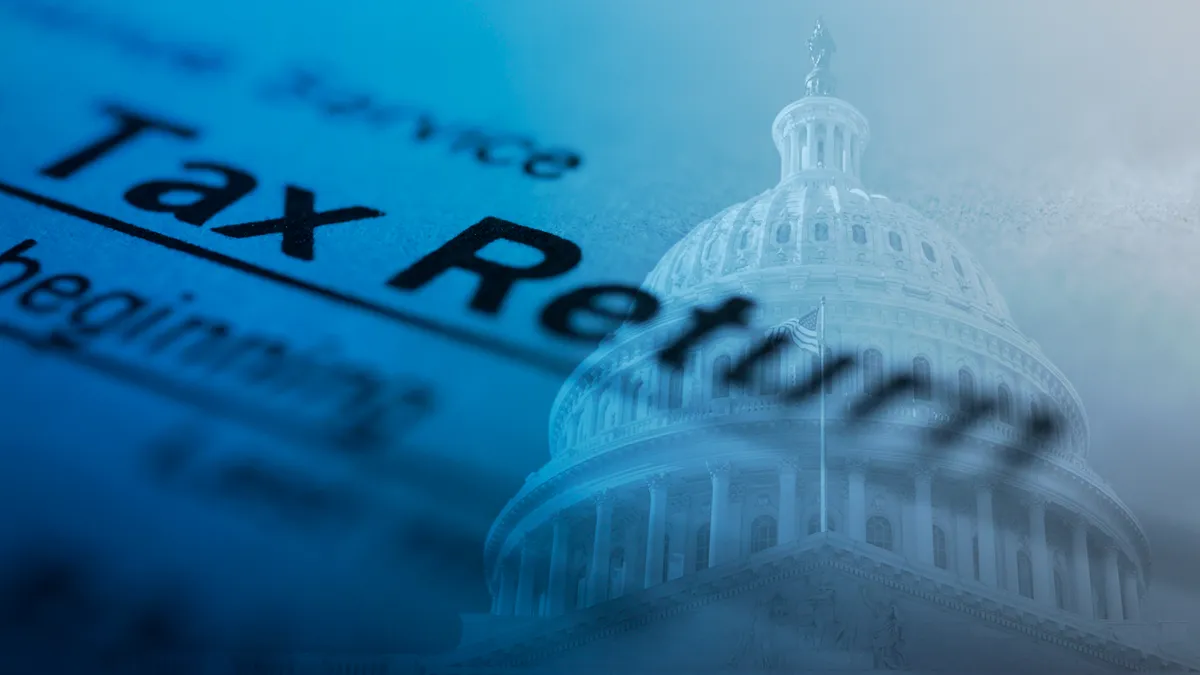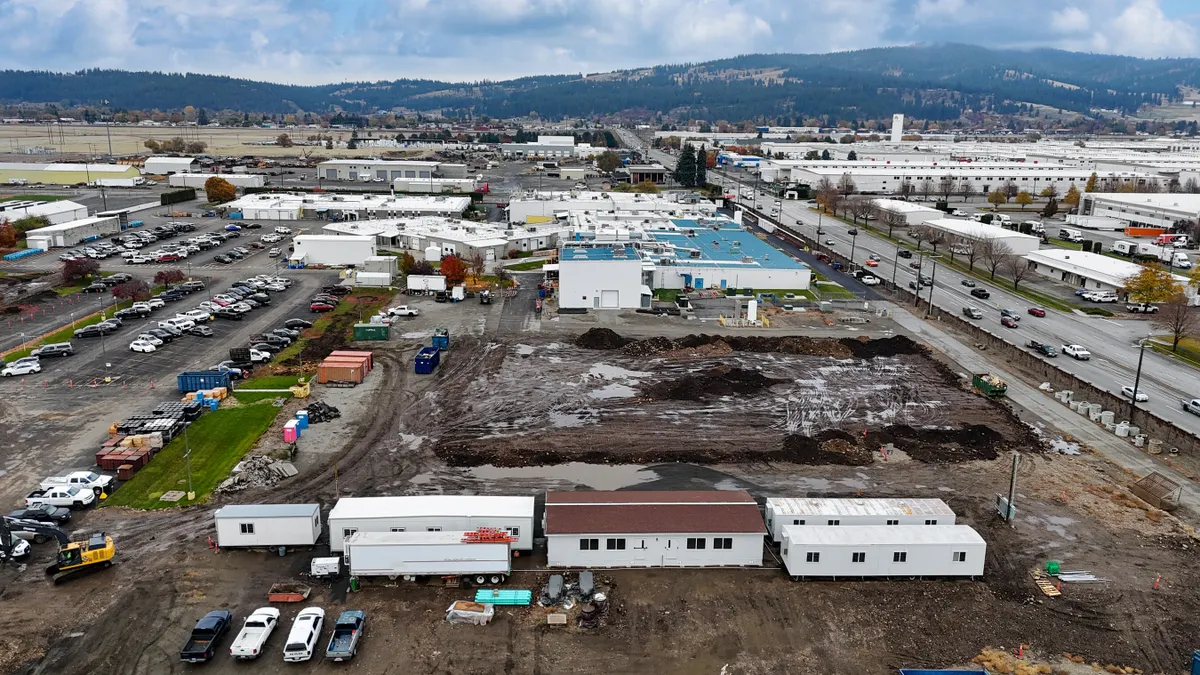This article is first in a series looking at what public and private construction firms pay in federal taxes and the techniques some of them use to minimize their tax burden. Click here for the entire package.
The largest U.S.-based public construction companies had an average effective federal tax rate of just 16.8% in 2020, roughly a fifth less than the current statutory corporate rate of 21% set by Congress, according to a Construction Dive analysis.
Of the 19 public companies in the sector that were profitable last year, 12 — or nearly two-thirds — paid less than the statutory rate.
Four public construction firms enjoyed a negative tax rate at the federal level, where they received a rebate from the government, and three had an effective federal tax rate of zero.
| Total Revenue |
Adjusted U.S. Profits | Current Federal Taxes Paid | Effective Federal Tax Rate | |
|---|---|---|---|---|
| Tutor Perini | $5,318.8 | $95.8 | -$36.2 | -37.8% |
| Aegion* | $807.8 | $8.2 | -$1.7 | -20.6% |
| Jacobs Engineering | $13,567 | $213.3 | -$37 | -17.4% |
| Integrated Electrical Services | $1,190.9 | $45.6 | -$39k | -0.1% |
| Infrastructure and Energy Alternatives | $1,752.9 | $13.3 | $0 | 0% |
| Great Lakes Dredge & Dock |
$733.6 | $94.7 | $0 | 0% |
| Orion Group Holdings | $709.9 | $21.6 | $0 | 0% |
SOURCE: Construction Dive analysis of corporate 10-K filings. In millions, except where noted.
*Now a private company
One year's tax results rarely give the full picture of what a corporation pays over time. In addition, 2020's tax burdens on companies were lowered by provisions in the Coronavirus Aid, Relief and Economic Security (CARES) Act. Companies can also carry forward losses from previous years to offset current profits.
Many corporations across different industries often pay less than the statutory rate in a given year – Amazon, for instance, is a perennially profitable firm that often pays nothing — but the results among construction firms stand out.
For example, public construction and engineering companies enjoyed some of the lowest effective federal tax rates — the percentage of U.S. profits they actually pay to the federal government after deductions and credits — of any industry when compared to broader analyses of corporate tax rates before the pandemic.
Just look at 2018, the first full tax year after former President Donald Trump's Tax Cuts and Jobs Act went into effect to lower the corporate rate from 35% to 21%, when the construction and engineering sector had an overall effective federal tax rate of just 8%, according to the Institute on Taxation and Economic Policy, a left-leaning think tank.
That was less than half the effective average federal rate of 19.4% paid by all public companies that year, according to a separate analysis by the Tax Foundation, a right-leaning think tank. It was also smaller than the 11.3% effective federal tax rate among all profitable Fortune 500 companies that year, according to ITEP.
| Industry | 2018 Tax Rate |
|---|---|
| Industrial machinery | -0.6% |
| Utilities, gas and electric | -0.5% |
| Motor vehicles and parts | 1.5% |
| Oil, gas and pipelines | 3.6% |
| Chemicals | 4.4% |
| Engineering and construction | 8% |
| Transportation | 8% |
| Miscellaneous services | 8.3% |
| Publishing, printing | 9.8% |
| Financial | 10.2% |
| Miscellaneous manufacturing | 11.5% |
| Telecommunications | 12% |
| Aerospace and defense | 12.3% |
| Financial data services | 13.6% |
| Food, beverages and tobacco | 13.6% |
| Retail and wholesale trade | 14.4% |
| Metals and metal products | 16.1% |
| Household and personal products | 18.8% |
| Internet services and retailing | 20.2% |
| Computers, office equipment, software and data | 20.4% |
| Healthcare | 20.7% |
| Pharmaceuticals and medical products | 22% |
SOURCE: Institute on Taxation and Economic Policy analysis of corporate 10-K filings. In millions.
"There's this huge, persistent gap between the legal corporate tax rate, and the effective rate that companies are actually paying," said Matthew Gardner, senior fellow at ITEP and one of the study's authors.
Public debate
How much corporations actually pay in taxes has received widespread scrutiny this year, as President Joe Biden has proposed raising the corporate rate from 21% to 28% to pay for his $2.3 trillion American Jobs Plan, which focuses on rebuilding infrastructure. A bipartisan group of senators has made a counter proposal of nearly $1 trillion in spending, which they say can be paid for without raising the corporate tax rate. But which plan, if any, will finally pass is still unknown.
Construction companies, which stand to directly benefit from that spending perhaps more than any other sector, have nonetheless cried foul at the concept of raising taxes to enable it.
"The president's proposal to finance the new investments primarily via an increase in the corporate tax rate will likely undermine many of its economic benefits," said Stephen E. Sandherr, CEO of the Associated General Contractors of America in a statement about Biden's plan. "The tax hikes will… undermine firms' ability to invest in new equipment and technology and will limit America's global competitiveness."
Based on the Construction Dive analysis, Los Angeles-based Tutor Perini had the lowest effective federal tax rate of the companies analyzed, at negative 37.8%. It received a rebate — an accounting term applied to the credits corporations accrue with the IRS when their deductions hit negative territory — of $36.2 million on $95.8 million in adjusted profits. Jorge Casado, Tutor Perini's vice president of investor relations, said the company's taxes were lowered in part in 2020 due to benefits included in the CARES Act.
Other profitable construction firms with negative effective federal tax rates included Aegion (-20.6%); Jacobs (-17.4%); and Integrated Electrical Services (-0.1%).
Infrastructure and Energy Alternatives, Great Lakes Dredge & Dock and Orion Group Holdings all had a 0% effective federal tax rate. In an email to Construction Dive, IEA noted that it "pays millions of dollars in employment related and sales taxes" each year, something all firms are responsible for.
Not all companies got off scot-free. Twelve public firms in the Construction Dive analysis had a positive federal tax rate, with five of those paying less than 21%.
Hollywood, Florida-based NV5 Global had the highest effective federal rate, at 62%. It paid $13.2 million in taxes on $21.3 million in profits.
| Total Revenue |
Adjusted U.S. Profits | Current Federal Taxes Paid | Effective Federal Tax Rate | |
|---|---|---|---|---|
| Sterling Construction | $1,427.4 | $59.6 | $3 | 5.1% |
| Tetra Tech | $2,994.9 | $202.6 | $24.1 | 11.9% |
| MasTec | $6,321 | $413.3 | $70.6 | 17.1% |
| Construction Partners | $785.7 | $52 | $9 | 17.2% |
| Comfort Systems USA | $2,856.6 | $178.7 | $36.6 | 20.5% |
| Limbach Holdings | $568.2 | $5.8 | $1.3 | 22.0% |
| Quanta Services | $11,202.7 | $580.8 | $134.5 | 23.2% |
| MYR Group | $2,247.4 | $70.8 | $19 | 26.8% |
| Primoris Services | $3,491 | $133.7 | $37.3 | 27.9% |
| AECOM | $13,240 | $40.2 | $21.8 | 54.2% |
| Emcor | $8,797 | $192 | $115.6 | 60.2% |
| NV5 Global | $659.3 | $21.3 | $13.2 | 62.0% |
SOURCE: Construction Dive analysis of corporate 10-K filings. In millions.
By the numbers
In order to calculate construction firms' effective federal tax rates, Construction Dive looked at the 25 largest U.S.-based public engineering, construction and specialty contractors by revenue, beginning with their total U.S. profits.
Six of those firms — Fluor, API Group, Granite, Matrix Service Co., HC2 Holdings and Williams Industrial Services — reported U.S. losses in 2020. Since the U.S. tax system only collects money on profits, the analysis looked at the remaining 19 profitable companies.
Because construction firms often have joint ventures with other companies on specific projects, profits from these so-called "noncontrolling assets," for which parent corporations may not have a tax liability, were subtracted out. They're often paid by the joint venture directly.
State taxes paid were also removed from profits, (or added back, in the case of state tax rebates) since those result in a deduction or addition to profits at the federal level. This adjusted net profit number was then divided into the company's total federal taxes paid.
To calculate the average effective federal tax rate, all company taxes paid were combined, and divided by the sum of all adjusted profits.
When a firm's effective tax rate is negative, it indicates the company received what's known in accounting parlance as a rebate on its taxes. Corporations don't generally get a refund check from the government, as individual taxpayers do. Instead, they are credited for future taxes they may owe. So a negative balance in one year can offset future taxes in another.
Four strategies public firms use to decrease their tax liability include depreciation on assets, research and development tax credits, executive stock option compensation treated as an expense and the loss carryforward method, which allows losses from a past year to be applied indefinitely in the future during a profitable period.
The CARES Act also allowed companies to carry back losses from 2018, 2019 and 2020 for five years, which enables them to effectively amend past tax returns and receive rebates for those losses. Construction Dive will explore these techniques in a future article.
Benefits and risks
While construction groups like the AGC have fought an increase in the corporate rate, some within the sector counter that the scale of proposed infrastructure spending will far outweigh any tax increases corporations will face, and that to achieve bigger profits, companies may have to accept higher tax bills.
"If we see a significant increase in spending, it stands to reason that construction companies are going to see an increase in profits," said Erin Roberts, head of the global construction and engineering practice at consultancy Ernst & Young. "You may keep a little less of that than you would have otherwise if there's a higher tax rate, but you're still seeing an increase in profits that you wouldn't have had before," he said. "I always try to keep that in context for my clients."
During a recent Ernst & Young webinar, two-thirds of the 1,600 participants responded to a polling question that they were now open to taking on some additional tax burden in order to get an infrastructure deal passed.
"They've come up the learning curve in the sense of what the administration is trying to do and the longer-term impact it could have," Roberts said. "It's not just about winning one more project. It's about these businesses likely seeing real strength over an eight-year period."
While the debate around the federal infrastructure package — and who should pay for it — continues, tax experts also point to the bigger picture: how effective the tax code is at collecting revenue from profitable companies, including those in construction.
"If we're going to do corporate tax reform, we need to think simultaneously about two things," said Gardner. "One is where the legal tax rate ought to be. And the other is how close do we want to come to actually taxing companies at that rate."
Zachary Phillips contributed to this report.






















